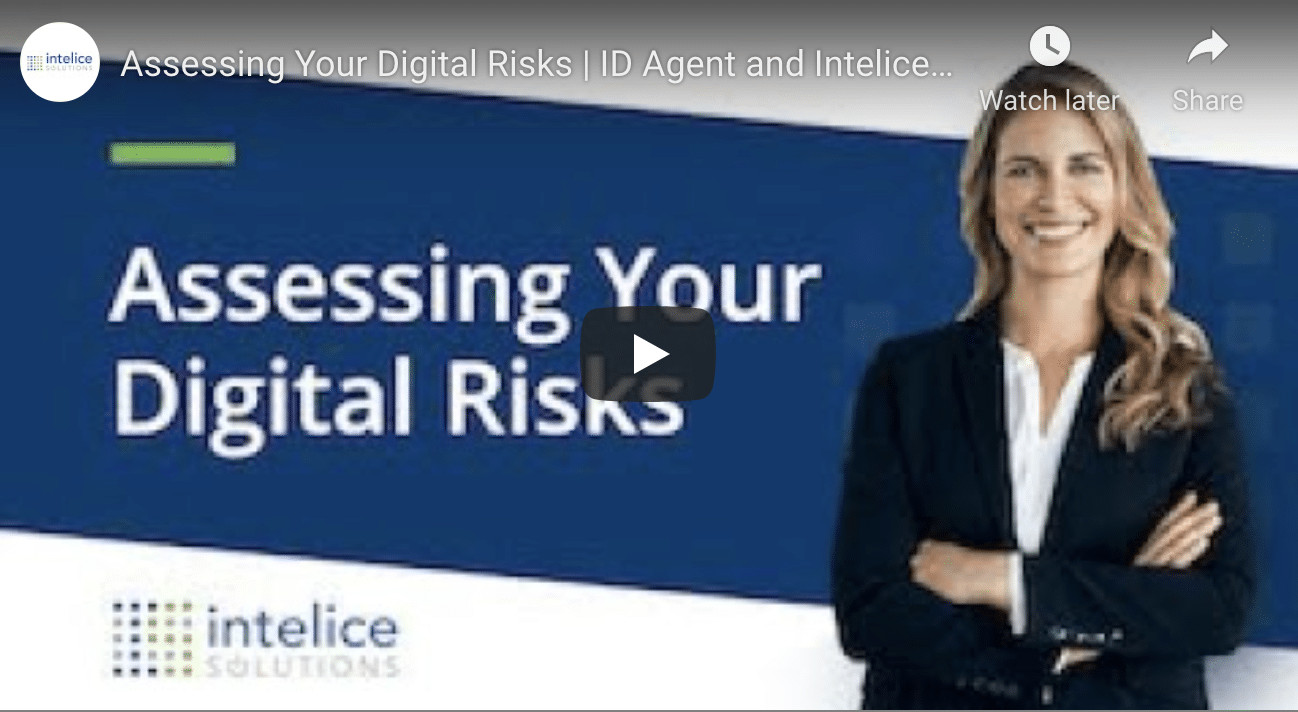Intelice Solutions: Blog

Assessing Your Digital Risks
Assessing Your Digital Risks
You hear about data breaches and identity theft every single day. Don’t make the mistake of assuming it’s all being exaggerated to get your attention.
If anything, there are too many data breaches for the news to keep up with:
- 81% of breaches are successful because the cybercriminal hacked weak passwords, or stole them in the first place.
- Data breaches exposed 4.1 billion records in the first six months of 2019
Given how common modern cybercrime is, one of your primary duties as your business’ leadership is making sure your data is protected.
But what if you’ve already been breached, and you just didn’t know it? After all, it takes most businesses up to 6 months to find out that they’ve experienced a data breach.
That’s why investing in protection isn’t enough — maintaining the integrity of your business’ data requires you to make sure it hasn’t already been compromised and put up for sale online.
There are a range of best practices and solutions to help you both protect data, and find out when it’s been compromised. For an overview, check out our latest webinar:
The Rising Rate Of Cybercrime
Did you know that 65% of organizations in the US have been hit by phishing? And it’s only getting worse.
Even if you haven’t been hit, you’ve definitely been a target. There are simply too many phishing emails being sent every day for you to avoid it.
Back in April, Google blocked 240 million phishing emails related to COVID-19 in one week alone. The bottom line is that you can’t ignore the threat of phishing.
How Can You Protect Your Data?
- Use Strong Passwords: Passwords remain a common cybersecurity weakness because of the careless way employees go about trying to remember their login information. Unfortunately, many users often opt for a weak password that’s easy to remember, rather than a strong one they’ll forget. The good news is that there is a way to get the best of both worlds — with a password manager. A password manager generates, keeps track of, and retrieves complex and long passwords for you to protect your vital online information. It also remembers your PINS, credit card numbers and three-digit CVV codes if you choose this option.
- Use A VPN: When you use a Virtual Private Network (VPN), your data is encrypted, or hidden, as it moves from your device to the VPN and then continues onto the Internet through what’s called an exit node. That makes it harder for an attacker to identify you as the source of the data — no matter whether you’re on your mobile device’s data connection, or using an unsecured retail Wi-Fi network while you’re in line for coffee.
- Use A Firewall: Your firewall is your first line of defense for keeping your information safe. A firewall is a particular type of solution that maintains the security of your network. It blocks unauthorized users from gaining access to your data. Firewalls are deployed via hardware, software, or a combination of the two.
- Be Careful Where You Click: Fake URLs are a popular tool for cybercriminals. Always be sure to hover your mouse over a link in an email, or on an unfamiliar website, before clicking it. That allows you to see where it actually leads. While it may look harmless, the actual URL may show otherwise, so always look, and rarely click.
- Protect Your Personal Information: Always double-check what you may be sharing on social media. With the wrong security settings, anyone can see what you post, including personal information that may make it easier for them to guess your passwords, answer your security questions, and pose as you online.
- Stay Safe While Mobile: Don’t download apps that aren’t approved by your smartphone provider’s app store. Unauthorized apps are a common way for hackers to sneak malware onto your device. Always be skeptical of the permissions you grant and the data you provide when using mobile technology.
- Check For The “S”: You should know that reputable URLs now start with “HTTPS” rather than “HTTP”. It’s easy to remember — the “s” stands for “secure”.
- Stay Up To Date: Did you know that one of the most common ways that cybercriminals get into a network is through loopholes in popular software? Much of the software you rely on to get work done every day could have flaws — or “exploits” — that leave you vulnerable to security breaches. To address this, developers regularly release software patches and updates to fix those flaws and protect users. This is why you must keep your applications and systems up to date
- Stay Vigilant: As discussed above, this is difficult — you need to pay attention to developments in cybercrime. If you don’t know how cybercriminals operate, how can you expect to stay ahead of them?
- Don’t Trust Technology: Always be skeptical of the technology you’re using. After all, it’s a product meant to be sold, and so, the top priority is often user experience, not user security. Here’s an example – when it comes to Wi-Fi connectivity settings, would you prioritize security or convenience? On one hand, it’s much more convenient to users if the device in question is configured to automatically connect to open and available Wi-Fi hot spots. But that’s not very secure, is it? That’s why it’s your responsibility to make up the difference if you actually want to maintain a higher level of security.
What Happens To Your Breached Data?
Despite your best efforts, you may still experience a data breach at some point. If that happens, you need to understand what cybercriminals do with that data.
When cybercriminals want to buy or sell private data, they go to the Dark Web.
The Dark Web is a small part of the much larger “deep web” — the common name for an extensive collection of websites that aren’t accessible through normal Internet browsers. These websites are hidden from everyday Internet users through the use of overlay networks.
How can you find out if your data is for sale online right now?
There’s only so much you can do on your own – but there are now more direct ways of checking whether your data has been compromised on the Dark Web.
Intelice Solutions Will Monitor The Dark Web For Your Data
Our Dark Web Monitoring service (using Dark Web ID) is designed to detect compromised credentials that surface on the dark web in real-time, offering your business a comprehensive level of data theft protection.
This enterprise-level service is tailored to businesses like yours. This dark web monitoring solution keeps tabs on the shadiest corners of the online world 24 hours a day, 7 days a week — no exceptions.
Here’s how to get started:
- Contact our team to arrange a Dark Web consultation.
- Our team will scour the Dark Web to find matches for your personal data.
- You can rest easy knowing your private data isn’t for sale online.




